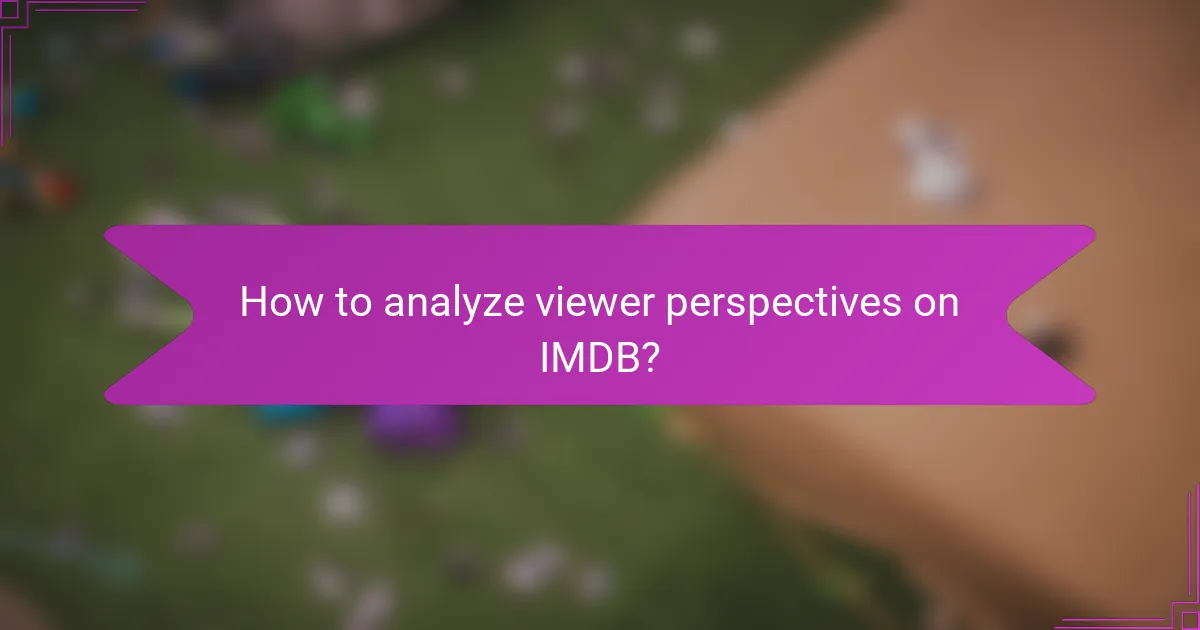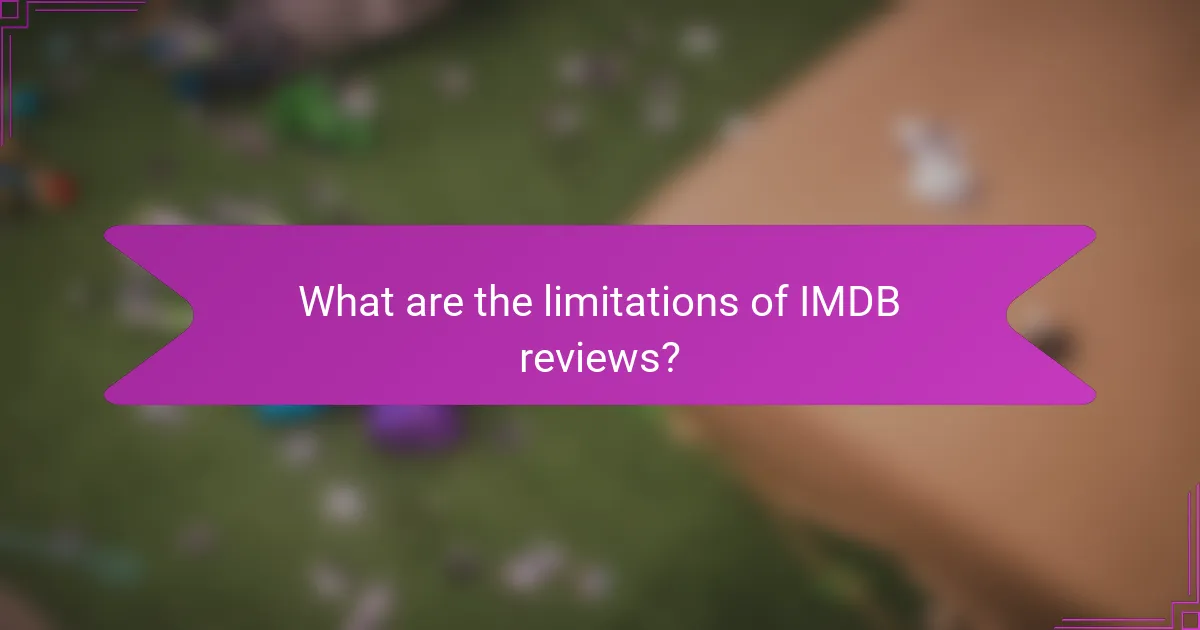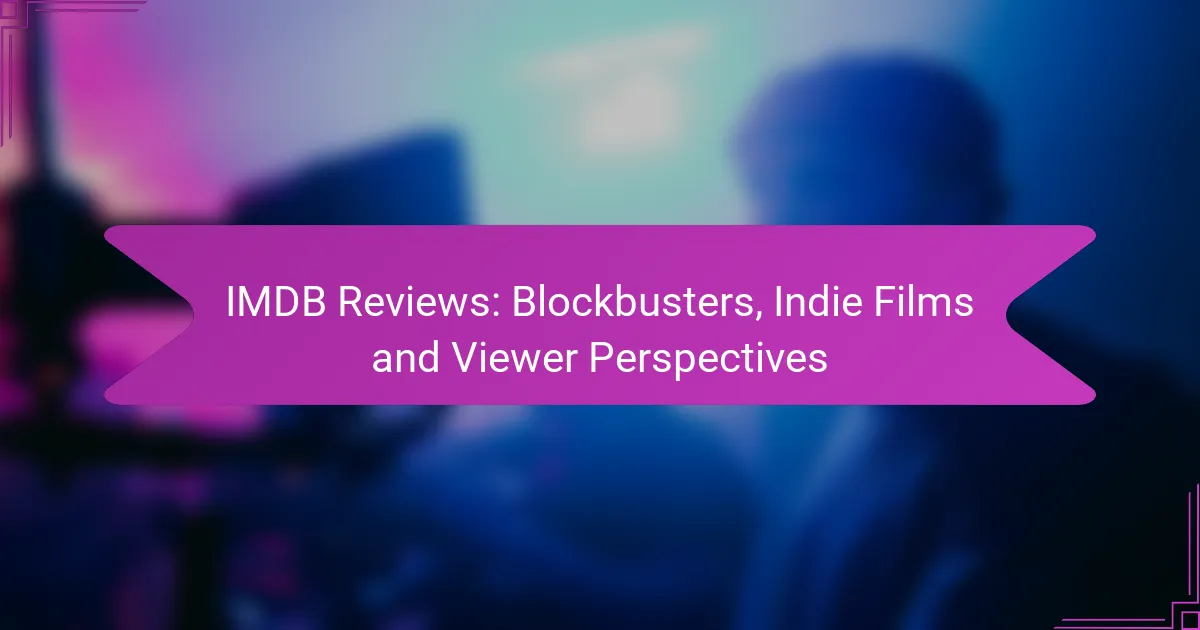IMDB reviews play a crucial role in shaping the landscape of both blockbuster and indie films, influencing public perception and viewer interest. For blockbusters, positive ratings can boost visibility and box office success, while indie films often benefit from reviews that highlight unique storytelling and character depth. By analyzing viewer perspectives, we can gain valuable insights into audience preferences and the overall impact of these reviews on future cinematic projects.

How do IMDB reviews impact blockbuster films?
IMDB reviews significantly influence blockbuster films by shaping public perception and driving viewer interest. Positive ratings can enhance a film’s visibility and box office success, while negative reviews may deter potential audiences.
Influence on box office performance
Box office performance is often directly correlated with IMDB ratings. Films with higher ratings tend to attract larger audiences, leading to increased ticket sales. For instance, a movie rated above 7.0 on IMDB may see a revenue boost of 20-30% compared to those rated below 5.0.
Producers and studios often monitor IMDB scores closely during a film’s opening weekend to gauge audience reaction. A strong rating can prompt additional marketing efforts, while a poor rating may lead to reduced promotional activities.
Viewer engagement metrics
IMDB reviews also affect viewer engagement metrics, such as the number of ratings and reviews submitted. Higher ratings often encourage more viewers to share their opinions, creating a feedback loop that can further enhance a film’s reputation.
Engagement can be measured through metrics like the average rating, total reviews, and the frequency of new reviews over time. Films that maintain a steady influx of positive reviews typically see sustained interest long after their release.
Critical acclaim vs. audience ratings
There is often a disparity between critical acclaim and audience ratings on IMDB. While critics may focus on artistic merit and technical execution, audience ratings reflect general enjoyment and relatability. A blockbuster might receive mixed reviews from critics but still achieve high audience scores.
This divergence can influence marketing strategies. Films with high audience ratings but low critical scores may be marketed as crowd-pleasers, appealing to viewers looking for entertainment rather than artistic depth.

What are the key features of IMDB reviews for indie films?
IMDB reviews for indie films often highlight unique storytelling, character depth, and production quality, which can differ significantly from mainstream offerings. These reviews provide insights into viewer perceptions, helping potential audiences gauge the film’s appeal and artistic merit.
Viewer demographics and preferences
Indie film audiences tend to be younger and more diverse compared to mainstream filmgoers. They often seek originality and emotional resonance, valuing storytelling over high-budget production. This demographic is typically more engaged with niche genres and experimental narratives.
Many indie viewers appreciate films that challenge conventional norms, which is reflected in their reviews. They often express preferences for character-driven stories and innovative filmmaking techniques, making their feedback crucial for understanding market trends.
Trends in indie film ratings
Indie films generally receive a wide range of ratings on IMDB, often reflecting polarized viewer opinions. While some films achieve high ratings due to strong word-of-mouth and festival accolades, others may struggle to gain traction, resulting in lower scores. This variability can be attributed to the subjective nature of indie storytelling.
Recent trends show that films with strong social messages or unique perspectives tend to garner higher ratings. Viewers are increasingly drawn to films that resonate with contemporary issues, leading to a shift in how indie films are evaluated on platforms like IMDB.
Comparison with mainstream films
IMDB reviews for indie films often contrast sharply with those for mainstream films, highlighting differences in viewer expectations. Mainstream films typically focus on entertainment value and star power, while indie films prioritize artistic expression and narrative depth.
While mainstream films may achieve higher average ratings due to larger marketing budgets and wider releases, indie films can cultivate dedicated fan bases that appreciate their authenticity. This distinction is crucial for filmmakers and distributors when considering how to position their films in the market.

How to analyze viewer perspectives on IMDB?
Analyzing viewer perspectives on IMDB involves examining user reviews to gauge sentiment, identify recurring themes, and understand their influence on future projects. This analysis can provide valuable insights into audience preferences and expectations.
Sentiment analysis tools
Sentiment analysis tools help quantify the emotions expressed in IMDB reviews, categorizing them as positive, negative, or neutral. Popular tools include Natural Language Processing (NLP) software and sentiment analysis APIs, which can process large volumes of text efficiently.
When using these tools, consider the context of the reviews, as sarcasm or cultural references may skew results. Combining automated analysis with manual review can enhance accuracy and provide a more nuanced understanding of viewer sentiments.
Common themes in reviews
Common themes in IMDB reviews often include storytelling quality, character development, and pacing. For instance, many viewers may praise a film for its engaging plot while criticizing its slow buildup.
Identifying these themes can guide filmmakers and producers in understanding what resonates with audiences. Regularly reviewing feedback can help in adapting future projects to better meet viewer expectations.
Impact of reviews on future projects
Reviews on IMDB can significantly impact future projects by influencing funding decisions, marketing strategies, and audience engagement. Positive reviews can lead to increased interest and investment, while negative feedback may prompt reevaluation of a film’s direction or sequel potential.
Filmmakers should monitor IMDB ratings and comments closely, as they reflect current viewer sentiments and trends. Engaging with audiences through social media or forums can also provide additional insights into how reviews shape perceptions and future content development.

What are the differences in IMDB reviews across genres?
IMDB reviews vary significantly across genres, reflecting the distinct expectations and experiences of viewers. Each genre tends to attract different audience demographics, which influences the overall ratings and feedback provided.
Genre-specific rating trends
Rating trends on IMDB often show that blockbuster films, such as action and superhero movies, typically receive higher average scores compared to indie films. While blockbusters may score in the range of 7 to 9 out of 10, indie films often hover around 6 to 8, reflecting a more niche audience that appreciates unique storytelling.
Additionally, genres like horror and comedy can exhibit polarized ratings, where some films receive extreme praise or criticism. For instance, a horror film might score as low as 4 or as high as 8, depending on its execution and audience reception.
Viewer expectations by genre
Viewer expectations vary widely by genre, influencing how films are rated on IMDB. Audiences typically seek thrilling experiences in action films, while they may prioritize emotional depth in dramas. This difference shapes the criteria by which viewers judge a film’s quality.
For example, a romantic comedy may be expected to deliver humor and chemistry, leading to higher ratings when these elements are executed well. Conversely, a drama that fails to engage emotionally may receive lower scores, even if it has strong production values.
Critical reception across genres
Critical reception on IMDB can differ based on genre conventions and audience familiarity. Critics often evaluate films against genre benchmarks, which can lead to discrepancies between critic and user ratings. For instance, a well-crafted indie drama might receive critical acclaim but lower audience scores if it doesn’t meet viewer expectations for entertainment.
Moreover, genres like documentaries may receive higher ratings from critics who appreciate their informative content, while general audiences might rate them lower due to a preference for more traditional narrative structures. This divergence highlights the importance of understanding how genre influences both critical and viewer perspectives on films.

How do IMDB reviews influence film marketing strategies?
IMDB reviews significantly shape film marketing strategies by providing insights into audience perceptions and preferences. Marketers leverage these reviews to tailor promotional content and target specific demographics effectively.
Utilizing reviews in promotional content
Film marketers often incorporate positive IMDB reviews into trailers, posters, and social media campaigns to enhance credibility. Highlighting quotes from reviews can attract viewers by showcasing critical acclaim and audience approval.
For instance, a film with a high rating or glowing reviews may feature snippets in advertisements, creating a sense of urgency and desirability among potential viewers. This tactic can be particularly effective for both blockbuster releases and indie films.
Targeting audiences based on reviews
Marketers analyze IMDB reviews to identify specific audience segments and tailor their messaging accordingly. By understanding the demographics of reviewers, such as age and interests, campaigns can be designed to resonate with those groups.
For example, if a film receives positive feedback from younger audiences, marketing efforts can focus on platforms popular with that demographic, like TikTok or Instagram. This targeted approach can enhance engagement and drive ticket sales.
Case studies of successful campaigns
Several films have successfully utilized IMDB reviews to boost their marketing efforts. A notable example is an indie film that gained traction through social media campaigns highlighting viewer testimonials, resulting in increased box office performance.
Another case is a blockbuster that featured its high IMDB rating in promotional materials, which helped maintain momentum during its release week. These examples illustrate the power of leveraging audience feedback to create compelling marketing narratives.

What are the limitations of IMDB reviews?
IMDB reviews have several limitations that can affect their reliability and usefulness. These include potential biases in user ratings, the influence of review volume, and the lack of context in individual reviews.
Potential biases in user ratings
User ratings on IMDB can be influenced by various biases, such as personal preferences, social influences, and emotional responses. For instance, fans of a particular genre or franchise may rate their favorite films higher than they objectively deserve, skewing the overall score.
Additionally, the tendency for users to leave reviews shortly after watching a film can lead to impulsive ratings. This can result in inflated scores for popular blockbusters while indie films may receive lower ratings due to less visibility and fewer reviews.
To mitigate these biases, consider looking at the distribution of ratings rather than just the average score. A film with a high average rating but a wide range of scores may indicate polarized opinions, which can be more telling than the average alone.



